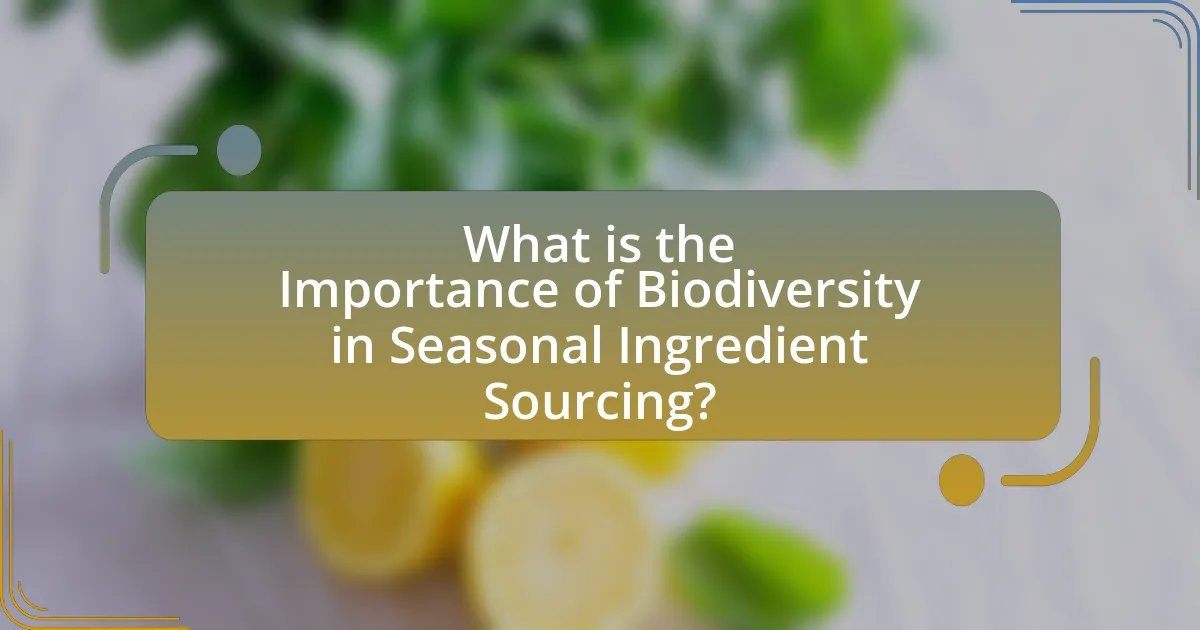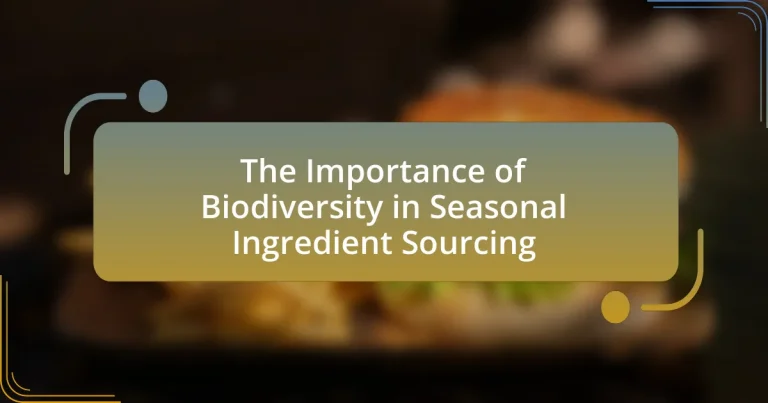Biodiversity is essential for seasonal ingredient sourcing as it enhances ecosystem resilience, ensuring a stable supply of diverse ingredients crucial for food security. The article explores the role of biodiversity in maintaining agricultural productivity, supporting adaptation to climate change, and providing ecological balance through natural pest control and pollination. It highlights the benefits of diverse agricultural systems, which yield more stable outputs compared to monocultures, and discusses the challenges biodiversity faces, including climate change and habitat loss. Additionally, the article outlines best practices for promoting biodiversity in sourcing, emphasizing the importance of local and sustainable agricultural practices for preserving ecosystems and enhancing food quality.

What is the Importance of Biodiversity in Seasonal Ingredient Sourcing?
Biodiversity is crucial in seasonal ingredient sourcing as it enhances ecosystem resilience, ensuring a stable supply of diverse ingredients. A rich variety of species contributes to ecological balance, which is essential for maintaining soil health, pest control, and pollination. For instance, studies show that diverse agricultural systems can yield up to 20% more than monocultures, demonstrating the benefits of biodiversity in food production. Additionally, biodiversity supports the adaptation of crops to changing climate conditions, thereby securing food sources against environmental fluctuations.
Why is biodiversity crucial for seasonal ingredient sourcing?
Biodiversity is crucial for seasonal ingredient sourcing because it ensures a variety of species that can adapt to changing environmental conditions, thus maintaining a stable supply of ingredients throughout different seasons. Diverse ecosystems provide resilience against pests, diseases, and climate fluctuations, which can threaten food production. For instance, a study published in the journal “Nature” found that agricultural systems with higher biodiversity yield more stable outputs, reducing the risk of crop failure. This stability is essential for sourcing seasonal ingredients, as it allows for consistent availability and quality, ultimately supporting food security and economic viability in agriculture.
What role does biodiversity play in ecosystem stability?
Biodiversity plays a crucial role in ecosystem stability by enhancing resilience to environmental changes and disturbances. Diverse ecosystems are better equipped to withstand stressors such as climate change, disease, and invasive species, as they contain a variety of species that fulfill different ecological roles. For instance, a study published in the journal “Nature” by Cardinale et al. (2012) demonstrated that ecosystems with higher species diversity are more productive and stable over time, as they can maintain functionality even when some species are lost. This stability is vital for sustaining ecosystem services, such as food production and water purification, which are essential for human survival and well-being.
How does biodiversity influence food security?
Biodiversity significantly influences food security by enhancing ecosystem resilience, which is crucial for maintaining agricultural productivity. Diverse ecosystems support a variety of crops and livestock, reducing vulnerability to pests, diseases, and climate change impacts. For instance, a study published in the journal “Nature” found that agricultural systems with higher biodiversity can yield up to 20% more food than monocultures, as they utilize resources more efficiently and provide a buffer against environmental stresses. This relationship underscores the importance of preserving biodiversity to ensure stable and sustainable food supplies.
How does seasonal ingredient sourcing benefit from biodiversity?
Seasonal ingredient sourcing benefits from biodiversity by enhancing the resilience and nutritional diversity of food systems. Biodiversity ensures a variety of crops and livestock, which can adapt to changing climate conditions and pest pressures, thereby maintaining consistent food supply throughout different seasons. For instance, diverse ecosystems can provide natural pest control and pollination services, reducing the need for chemical inputs and promoting sustainable agricultural practices. Studies have shown that farms with higher biodiversity yield more stable harvests, as they are less susceptible to disease and environmental stressors. This relationship between biodiversity and seasonal sourcing ultimately leads to improved food security and healthier diets.
What are the advantages of using diverse ingredients in seasonal menus?
Using diverse ingredients in seasonal menus enhances flavor, nutrition, and sustainability. The incorporation of a variety of ingredients allows chefs to create more complex and appealing dishes, which can attract a wider range of customers. Nutritionally, diverse ingredients provide a broader spectrum of vitamins and minerals, contributing to healthier meal options. Furthermore, sourcing a variety of seasonal ingredients supports local agriculture and reduces the carbon footprint associated with food transportation. Research indicates that diverse agricultural practices can improve ecosystem resilience, which is crucial for sustainable food systems.
How can biodiversity enhance flavor and nutrition in seasonal dishes?
Biodiversity enhances flavor and nutrition in seasonal dishes by providing a wide variety of ingredients that contribute unique tastes and essential nutrients. Diverse plant and animal species offer distinct flavors, which can elevate the overall culinary experience; for example, heirloom tomatoes have a richer taste compared to standard varieties due to their genetic diversity. Additionally, a variety of fruits, vegetables, and herbs can supply a broader spectrum of vitamins, minerals, and antioxidants, which are crucial for health. Research indicates that diets rich in diverse foods are linked to improved health outcomes, as they can reduce the risk of chronic diseases. Thus, incorporating biodiversity into seasonal cooking not only enriches flavor profiles but also enhances nutritional value.
What challenges does biodiversity face in seasonal ingredient sourcing?
Biodiversity faces significant challenges in seasonal ingredient sourcing primarily due to climate change, habitat loss, and overexploitation. Climate change alters the growing conditions for various species, leading to shifts in their distribution and availability. For instance, rising temperatures can affect the phenology of plants, causing mismatches between the timing of harvest and the availability of pollinators, which are crucial for many crops. Habitat loss, driven by urbanization and agricultural expansion, reduces the natural ecosystems that support diverse species, further threatening their survival. Overexploitation of certain species for seasonal ingredients can lead to population declines, disrupting the balance of ecosystems. According to the Intergovernmental Science-Policy Platform on Biodiversity and Ecosystem Services (IPBES), approximately 1 million species are at risk of extinction, highlighting the urgent need to address these challenges to maintain biodiversity in seasonal ingredient sourcing.
What are the impacts of climate change on biodiversity?
Climate change significantly impacts biodiversity by altering habitats, disrupting ecosystems, and threatening species survival. Rising temperatures and changing precipitation patterns lead to habitat loss, as many species cannot adapt quickly enough to the new conditions. For instance, a study published in the journal “Nature” indicates that climate change could push one in six species to extinction by 2100 if current trends continue. Additionally, ocean acidification, a direct result of increased carbon dioxide levels, affects marine biodiversity, particularly coral reefs, which are vital for numerous marine species. These changes not only threaten individual species but also disrupt the intricate relationships within ecosystems, leading to a decline in overall biodiversity.
How do agricultural practices affect biodiversity levels?
Agricultural practices significantly affect biodiversity levels by altering habitats, introducing monocultures, and applying chemical inputs. Intensive farming methods, such as monoculture cropping, reduce the variety of plant and animal species in an ecosystem, leading to decreased genetic diversity. For instance, studies show that regions with high monoculture farming exhibit up to 50% less species richness compared to diverse agricultural systems. Additionally, the use of pesticides and fertilizers can harm non-target species, disrupting food webs and leading to declines in pollinator populations, which are crucial for many crops. Research published in “Biodiversity and Conservation” highlights that sustainable agricultural practices, such as crop rotation and organic farming, can enhance biodiversity by promoting a wider range of species and healthier ecosystems.
How can we promote biodiversity in seasonal ingredient sourcing?
Promoting biodiversity in seasonal ingredient sourcing can be achieved by prioritizing the use of a diverse range of local crops and ingredients. This approach supports local ecosystems and reduces reliance on monocultures, which can deplete soil health and increase vulnerability to pests and diseases. Research indicates that diverse agricultural systems can enhance resilience and productivity; for instance, a study published in the journal “Nature” found that crop diversity can lead to improved yields and reduced pest outbreaks. By sourcing a variety of seasonal ingredients, businesses can contribute to the preservation of genetic diversity and support sustainable farming practices, ultimately benefiting both the environment and local economies.
What practices can chefs adopt to support biodiversity?
Chefs can adopt practices such as sourcing seasonal and local ingredients, utilizing diverse plant species, and minimizing food waste to support biodiversity. By prioritizing seasonal and local sourcing, chefs reduce the carbon footprint associated with transportation and promote the cultivation of native crops, which enhances local ecosystems. Utilizing diverse plant species in menus encourages the preservation of heirloom varieties and reduces reliance on monocultures, which are detrimental to biodiversity. Additionally, minimizing food waste through creative use of all parts of ingredients and composting practices helps maintain ecological balance by returning nutrients to the soil. These practices collectively contribute to a more sustainable food system that supports biodiversity.
How can consumers influence biodiversity through their choices?
Consumers can influence biodiversity through their choices by opting for sustainably sourced products and supporting local, organic farming practices. When consumers prioritize products that are certified organic or sustainably harvested, they contribute to the preservation of diverse ecosystems and reduce the demand for monoculture farming, which often leads to habitat destruction. For instance, a study published in the journal “Nature” found that organic farming can enhance biodiversity by providing habitats for various species, thus promoting ecological balance. Additionally, choosing seasonal ingredients encourages agricultural practices that align with natural growing cycles, further supporting local biodiversity.
What are the best practices for sourcing seasonal ingredients sustainably?
The best practices for sourcing seasonal ingredients sustainably include prioritizing local sourcing, supporting organic and regenerative farming, and minimizing food waste. Local sourcing reduces transportation emissions and supports local economies, while organic and regenerative farming practices enhance soil health and biodiversity. Additionally, minimizing food waste through proper inventory management and utilizing imperfect produce contributes to sustainability efforts. Research indicates that local food systems can reduce carbon footprints by up to 25% compared to conventional supply chains, highlighting the effectiveness of these practices in promoting sustainability.
How can local sourcing contribute to biodiversity preservation?
Local sourcing contributes to biodiversity preservation by promoting the use of native species and reducing reliance on monoculture farming practices. When consumers choose locally sourced products, they support agricultural systems that prioritize diverse crop varieties, which enhances ecosystem resilience. Research indicates that diverse agricultural systems can improve soil health and reduce pest outbreaks, thereby fostering a more balanced ecosystem. Additionally, local sourcing minimizes transportation emissions, which helps mitigate climate change impacts that threaten biodiversity. By encouraging sustainable farming practices and protecting local habitats, local sourcing plays a crucial role in maintaining biodiversity.
What resources are available for chefs to learn about biodiversity in sourcing?
Chefs can access various resources to learn about biodiversity in sourcing, including online courses, workshops, and publications. Notable platforms such as the Culinary Institute of America offer courses focused on sustainable sourcing and biodiversity. Additionally, organizations like the Slow Food movement provide educational materials and events that emphasize local biodiversity and seasonal ingredients. Research papers, such as “Biodiversity and Sustainable Diets” published by the Food and Agriculture Organization, also serve as valuable references for understanding the impact of biodiversity on food systems. These resources collectively enhance chefs’ knowledge and practices regarding biodiversity in ingredient sourcing.


